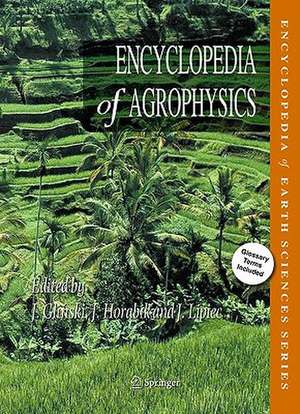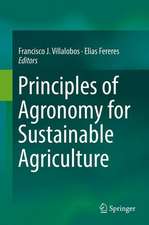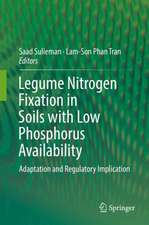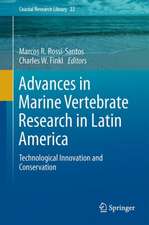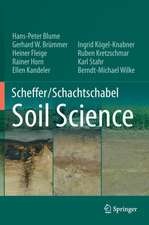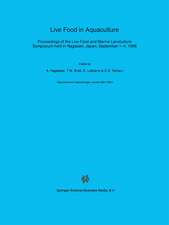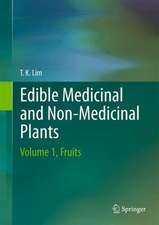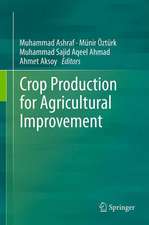Encyclopedia of Agrophysics: Encyclopedia of Earth Sciences Series
Winfried E. H. Blum Editat de Jan Gliński Josse de Baerdemaeker Editat de Józef Horabik Charles W. Finkl Editat de Jerzy Lipiec Rainer Horn, Yakov Pachepsky, Eugene V. Shein, Krystyna Konstankiewicz, Stanislaw Grundasen Limba Engleză Hardback – 7 iun 2011
In a single authoritative volume a collection of about 250 informative articles and ca 400 glossary terms covering all aspects of agrophysics will be presented. The authors will be renowned specialists in various aspects in agrophysics from a wide variety of countries.
Agrophysics is important both for research and practical use not only in agriculture, but also in areas like environmental science, land reclamation, food processing etc.
Agrophysics is a relatively new interdisciplinary field closely related to Agrochemistry, Agrobiology, Agroclimatology and Agroecology. Nowadays it has been fully accepted as an agricultural and environmental discipline. As such this Encyclopedia volume will be an indispensable working tool for scientists and practitioners from different disciplines, like agriculture, soil science, geosciences, environmental science, geography, and engineering.
Din seria Encyclopedia of Earth Sciences Series
- 18%
 Preț: 3655.93 lei
Preț: 3655.93 lei - 18%
 Preț: 3123.97 lei
Preț: 3123.97 lei - 18%
 Preț: 2828.03 lei
Preț: 2828.03 lei - 18%
 Preț: 3984.35 lei
Preț: 3984.35 lei - 18%
 Preț: 3380.49 lei
Preț: 3380.49 lei - 18%
 Preț: 3917.94 lei
Preț: 3917.94 lei - 18%
 Preț: 3354.74 lei
Preț: 3354.74 lei - 18%
 Preț: 3664.42 lei
Preț: 3664.42 lei - 18%
 Preț: 1901.16 lei
Preț: 1901.16 lei - 18%
 Preț: 3381.42 lei
Preț: 3381.42 lei - 18%
 Preț: 3041.93 lei
Preț: 3041.93 lei - 18%
 Preț: 3055.49 lei
Preț: 3055.49 lei - 24%
 Preț: 2488.06 lei
Preț: 2488.06 lei - 24%
 Preț: 2672.29 lei
Preț: 2672.29 lei - 18%
 Preț: 1849.26 lei
Preț: 1849.26 lei - 24%
 Preț: 3329.20 lei
Preț: 3329.20 lei - 18%
 Preț: 2802.01 lei
Preț: 2802.01 lei - 24%
 Preț: 1685.65 lei
Preț: 1685.65 lei - 18%
 Preț: 3335.19 lei
Preț: 3335.19 lei - 24%
 Preț: 2953.18 lei
Preț: 2953.18 lei - 24%
 Preț: 1685.12 lei
Preț: 1685.12 lei - 24%
 Preț: 1689.65 lei
Preț: 1689.65 lei - 14%
 Preț: 2198.26 lei
Preț: 2198.26 lei - 9%
 Preț: 1677.82 lei
Preț: 1677.82 lei - 14%
 Preț: 1632.58 lei
Preț: 1632.58 lei - 14%
 Preț: 1849.21 lei
Preț: 1849.21 lei - 14%
 Preț: 2571.39 lei
Preț: 2571.39 lei - 14%
 Preț: 1945.49 lei
Preț: 1945.49 lei - 14%
 Preț: 1945.49 lei
Preț: 1945.49 lei - 14%
 Preț: 1945.49 lei
Preț: 1945.49 lei - 14%
 Preț: 1945.49 lei
Preț: 1945.49 lei - 9%
 Preț: 2703.12 lei
Preț: 2703.12 lei - 14%
 Preț: 1945.49 lei
Preț: 1945.49 lei - 14%
 Preț: 1945.49 lei
Preț: 1945.49 lei - 14%
 Preț: 2130.86 lei
Preț: 2130.86 lei
Preț: 2565.22 lei
Preț vechi: 3128.32 lei
-18% Nou
Puncte Express: 3848
Preț estimativ în valută:
490.85€ • 511.49$ • 406.43£
490.85€ • 511.49$ • 406.43£
Carte disponibilă
Livrare economică 13-27 martie
Preluare comenzi: 021 569.72.76
Specificații
ISBN-13: 9789048135844
ISBN-10: 9048135842
Pagini: 900
Ilustrații: XLVI, 1028 p. 421 illus., 168 illus. in color.
Dimensiuni: 210 x 279 x 56 mm
Greutate: 3.18 kg
Ediția:2011
Editura: SPRINGER NETHERLANDS
Colecția Springer
Seria Encyclopedia of Earth Sciences Series
Locul publicării:Dordrecht, Netherlands
ISBN-10: 9048135842
Pagini: 900
Ilustrații: XLVI, 1028 p. 421 illus., 168 illus. in color.
Dimensiuni: 210 x 279 x 56 mm
Greutate: 3.18 kg
Ediția:2011
Editura: SPRINGER NETHERLANDS
Colecția Springer
Seria Encyclopedia of Earth Sciences Series
Locul publicării:Dordrecht, Netherlands
Public țintă
ResearchCuprins
Absorption.- Acoustic tomography.- Adherence.- Adhesion.- Adsorption complex.- Adsorption energy and surface heterogeneity.- Advances in soil water system.- Aeration.- Aeration and soil enzymes.- Aerial photography.- Aerial photography use for soils and plants.- After-effect.- After- effect phenomenon in environment.- Aggregate-size distribution.- Agricultural products.- Agrophysical metrology.- Agrophysical objects (soils, plants, plant materials, plant products, near ground atmosphere, animals).- Agrophysical relations.- Agrophysics Physics applied to agriculture.- Agrophysics in modern technologies.- Air dry.- Air entry value.- Air porosity.- Air space ratio.- Amelioration.- Anaerobiosis.- Anaerobiosis and its role in environment.- Angle of friction.- Angle of reflection.- Angle of refraction.- Angle of repose.- Angle of shearing resistance.- Angle of slide.- Angle of torsion.- Anion exchange.- Anthric saturation.- Apparent cohesion.- Apparent density.- Apparent features of soils and plant materials.- Apparent specific gravity.- Apparent viscosity.- Apparent volume.- Apparent weight.- Atmosphere near ground (Microclimate).- Bedrock.- Bending force.- Bending load.- Bending properties of plants.- Bending strength.- Bending stress.- Biodynamics.- Biological responses to environmental physical coditions.- Biophysics.- Bound water.- Buffer capacity.- Bulk density.- Bulk materials.- Bulk modulus.- Bulk properties.- Bulk specific gravity.- Bulk volume.- Bypass flow, soil.- Capillary properties of soils.- Capillary ascencion.- Capillary condensention.- Capillary conductivity.- Capillary flow.- Capillary fringe.- Capillary pores.- Capillary porosity.- Capillary potential.- Capillary pressure.- Capillary rise.- Capillary water.- Capillary zone.- Catena.- Cation exchange.- Cation exchange capacity (CEC).- Cavitation.- Chelates.- Cheluviation.- Clay.- Clay minerals and organo-mineral associates.- Claypan.- Claypan and its environmental effects.- Clod.-Coefficient of conductivity.- Coefficient of deformation.- Coefficient of dilatability.- Coefficient of dispersion.- Coefficient of elasticity.- Coefficient of elasticity.- Coefficient of expansion.- Coefficient of external friction.- Coefficient of friction.- Coefficient of internal friction.- Coefficient of linear extensibility (COLE).- Coefficient of permeability.- Coefficient of resistance.- Coefficient of heat transfer.- Coherence.- Cohesion.- Colloid.- Color feature in soils and fruit evaluation.- Compaction,soil.- Compression curve, index, stress.- Compressive force.- Concentrated flow, soil.- Condensation.- Conductance.- Conduction.- Conductivity.- Cone index.- Cone penetrometer.- Confocal technique in microstructure analysis.- Consistency index, constance, soil.- Contact angle.- Controlled traffic.- Convection of heat.- Convection of current.- Cracking, creeping, crusting and sealing phenomena in soils.- Critical angle.- Critical density.- Critical features of soil and plant materials.- Critical pressure.- Critical stress.- Critical void ratio.- Crop responses to soil physical conditions.- Crop responses to soil compaction.- Crumb.- Crushing strength.- Crust, soil.- Cumulative infiltration, soil.- Cumulative distribution, soil.- Cutanic material.- Databases.- Darcys law.- Deep percolation.- Deflation.- Degree of compactness.- Degree of saturation.- Degree of damage.- Degree of deformation.- Degree of hardness.- Desication crack, soil.- Detachment.- Dew point.- Dielectric conductivity.- Dielectric constant.- Dielectric permittivity.- Differential water capacity.- Differential weathering.- Diffuse layer.- Diffuse double layer.- Diffuse radiation.- Diffusivity.- Direct shear test.- Discharge curve.- Dispersivity.- Distribution of physical features in soils and plants.- Drain.- Drainage.- Drainage its advantages and disadvantages.- Drainage basin.- Drainage density.- Dry bulk density.- Dry mass.- Drying processes of plant materials.- Duripan.-Dynamic load.- Dynamic pressure.- Dynamic soil and plant physical processes.- Dynamic strength.- Dynamic viscosity.- Ecoenergy.- Ecohydrology.- Ecohydrological processes.- Effective energy.- Effective force.- Effective porosity.- Effective precipitation.- Effective strain.- Effective stress.- Elastic deformation.- Elasticity.- Elastic limit.- Elastic strain.- Elastic stress.- Elasto-plastic strain.- Elasto-plastic body.- Elastoplasticity.- Electrical properties of granular-powdery materials.- Electrical properties of soils and plant materials.- Electrical resistivity.- Electrokinetic (zeta) potential.- Electromagnetic fields use in agrophysical investigations.- Electromagnetic radiation in agrophysical invetigations.- Energetic products.- Energy flow.- Energy flux.- Energy of deformation.- Enzymes in soils and food products.- Equivalent depth.- Equivalent diameter.- Equivalent radius.- Erodibility.- Erosion.- Erosion environmental and economical hazard.- Erosive velocity.- Evaporation.- Evapotranspiration.- Exchange capacity.- Exchange complex.- Exchange complex and its role for agriculture and environment.- Exchange phenomena in soils.- Extensibility.- Extrusion.- Extrusion technique and effects.- Fabric.- Failure.- Fatigue strength.- Fatigue stress.- Fatigue test.- Field capacity.- Film water.- Fine earth.- Fine sand.- Finks law.- Fissure.- Flexural strength.- Flocculation and dispersion phenomena in soils.- Flow velocity.- Flux density.- Force of external friction.- Force of internal friction.- Fractal analysis of porous materials.- Fragipan.- Free water.- Friable structure.- Friction angle.- Friction coefficient.- Friction force.- Friction phenomena in soils.- Friction resistance.- Furrow erosion.- Furrow irrigation.- Gamma radiation.- Gammascopic methods for agricultural materials.- Gas diffusion.- Gas emission.- Gaseous phase, soil.- Gas production.- Gases production and emission (Soils, wetlands, landfills, animal production).- GeographicalInformation System) (GIS).- Geometry of solid phase.- Global positioning system (GPS).- Grain analysis.- Grain distribution.- Grain-to-ear binding force.- Granular objects.- Granular structure.- Granulometric analysis.- Granulometric composition.- Gravel.- Gravitational water.- Gravity flow.- Greenhouse gas fluxes: effects of physical conditions.- Greenhouse gases.- Ground penetrating radar (GPR).- Ground pressure.- Ground water level.- Ground water table.- Gully erosion.- Hard-pan.- Heat accumulation.- Heat balance.- Heat capacity.- Heat conduction.- Heat dissipation.- Heat emission.- Heat exchange.- Heat flow.- Heat flux density.- Heat losses.- Heat of wetting.- Heat, moisture and air transport in soil-plant-atmosphere system.- Heat properties of soils and plant materials.- Heat radiation.- Heat release.- Heavy clay.- Hydraulic conductivity.- Hydraulic conductivity effects on ground water pollution.- Hydraulic diffusivity.- Hydraulic gradient.- Hydraulic head.- Hydraulic pressure.- Hydraulic profile.- Hydraulic properties of soils.- Hydraulic sorptivity.- Hydrologic cycle.- Hydrophobic and hydrophyllic phenomena.- Hydrophysical properties of peat soils.- Hydrometry.- Hydrophobicity.- Hydrophillity.- Hygroscopicity.- Hygroscopic water.- Hypoxia.- Hysteresis.- Hysteresis phenomena in nature.- Image analysis for soils and plant materials.- Imbibition.- Impact analysis.- Impact energy.- Impact force.- Impact phenomena in soils and plant materials.- Impact resistance.- Impact strength.- Impact stress.- Impermeability.- Infiltration capacity.- Infiltration phenomana in soils.- Infiltration rate.- Infiltration water.- Infrared radiation.- Interception.- Interflow.- Internal friction.- Intrinsic permeability.- Intermolecular bonds.- Intermolecular forces.- Interrelationships: soil-plant-atmosphere-machine technology.- Irrigation.- Irrigation advantages and disatvantages.- Isothermal processes.- Kinematic viscosity.- Kriging.- Land reclamation.- Land use and management effects on soil and plant physical properties.- Laser beam.- Laser irradiation effect on plants.- Laser use in matter evaluation.- Latent heat.- Leaching of chemicals in relation to soil structure.- Leaf analysis.- Light pipe.- Light scattering.- Light velocity.- Lime-pan.- Liquid body.- Liquid phase, soil.- Liquid viscosity.- Loam.- Lodging, plant.- Loosening, soil.- Lysimeter.- Lysimeter and rhizotron for model experiments.- Macroaggregates.- Macropores.- Macroporosity.- Magnetic properties of soils.- Mass and energy transfer (exchange) in soil.- Mathematical modeling in agriculture and environment.- Matric potential.- Mechanical properties of soils and plant materials.- Microaggregates.- Microbial aspects of soil structure.- Micropores.- Microrelief.- Mineral soils.- Modern physical methods.- Modulus of elasticity.- Modulus of plasticity.- Modulus of rigidity.- Modulus of shearing.- Mohr circle.- Moisture-dependent physical properties of plant materials.- Moisture-holding capacity.- Moisture-retention curve.- Moisture tension.- Monitoring physical conditions in agriculture and environment.- Munsell color system use for soil and fruit evaluation.- Net radiation.- Neutron probe.- Non-destructive inspection.- Non-destructive load.- Non-destructive measurement in soils and agricultural products.- Non-limiting water range (NLWR), soil.- Normal stress.- Organic soils.- Ortstein.- Osmotic potential.- Osmotic pressure.- Oven-dry method.- Over-ground air layer.- Oxidation-reduction processes.- Oxidation-reduction reactions role in nutrient transformations in soils.- Oxygen diffusion rate (ODR), soil.- Oxygenology.- Packing density.- Packing voids.- Particle density.- Particle-size analysis.- Particle size distribution.- Perched water table.- Ped.- Pedotransfer function.- Peak discharge.- Penetrability.- Penetration resistance.- Penetrometry.- Percolation.- Permanent deformation.- Permanent load.- Permanent wilting point.- pF curve.- Permeability.- Phase equilibrium.- Physical degradation of soils and plant materials.- Physical methods of preservation plant materials.- Physical methods in soil reclamation.- Physical methods in storage.- Physical processes in food-chain production.- physical properties of soil, plant and agricultural products.- Physical properties of tropical fruits.- Physics in green (glass )houses.- Physics in lysimeter experiments.- Physics of biological materials.- Piezometer.- Plant lodging economic consequences.- Plant-machine relations.- Plasticity.- Plastic deformation.- Plow pan.- Plow sole.- Pore-size distribution C.- Pore structure.- Pore water potential.- Pore water pressure.- Pore water velocity.- Pores.- Porosity.- Porosity its role in soil processes.- Post harvest processing.- Precipitation interception.- Pre-compaction stress.- Pre-consolidation load.- Pre-consolidation pressure.- Preferential flow, soil.- Pressure gradient.- Prismatic soil structure.- Quality of agricultural products in relation to physical conditions.- Quick clay.- Radiant heat.- Radioactive tracer techniques in agriculture.- Rainfall interception.- Reclamation and remediation of physically degraded soils.- Redox potential.- Redoxymorphic features of soils.- Relative compaction.- Remote sensing use in agriculture.- Renewable energy sources.- Residual shrinkage.- Resilience.- Return flow.- Revetment.- Rheology in soils and agricultural products.- Rhizosphere.- Rhizotron.- Rill erosion.- Runoff.- Salinization.- Sand.- Sandy loam.- Sandy clay.- Saturated flow.- Saturated hydraulic conductivity.- Scaling.- Scale dependence relationship between soil physical propperties.- Sedimentation.- Seepage.- Sensitive slope.- Sensitive watershed.- Sensors for environmental monitoring.- Settling velocity.- Shear strength.- Shear strain.- Shear stress.- Sheet erosion.- Shrinkage and swelling phenomena.- Shrinkage.- Silt.- Soil aeration.- Soil aggregates.- Soil air characteristics.- Soil and plant materials thermal characteristics.- Soil andplant materials mechanical and rheological characteristics.- Soil compactibility and compressibility.- Soil compaction effects on environment.- Soil conservation.- Soil core.- Soil creep.- Soil dynamics and traction.- Soil enzymatic activity.- Soil erosion physical influences.- Soil hydraulic characterstics.- Soil improvement practices.- Soil loss equations.- Soil loss tolerance.- Soil - machine relations.- Soil machine plant relastions.- Soil management.- S-matrix.- Soil mechanics.- Soil micromorphology.- Soil moisture retention.- Soil physical conditions and plant water and nutrient use.- Soil physical stresses and plant response.- Soil physical quality.- Soil plant relations.- Soil plant atmosphere relations.- Soil plant food relations.- Soil pores.- Soil porosity.- Soil porous media and microbes.- Soil probe.- Soil redox properties.- Soil resilience.- Soil stabilization.- Soil strength.- Soil structure.- Soil suction.- Soil temperature.- Soil texture.- Soil tilth.- Soil water.- Soil water characteristics.- Soil water diffusivity.- Soil water management.- Soil water potential.- Soil water retention.- Soil water plant relations.- Soil wetness.- Soil tyre interaction.- Solidification.- Solid phase, soil.- Solid phase wettability consequences.- Sorptivity.- Spatial variability of soil and plant physical properties.- Spatial and temporal variability of soil physical properties.- Specific gravity.- Specific surface area.- Specific water capacity.- Spectral band.- Spectral colors.- Spectral radiance.- Splash detachment.- Static penetrometer.- Static soil and plant physical properties.- statistics in agrophysics.- Stem flow.- Sticky limit.- Sticky point.- Stokes law.- Stoniness.- Storage hazards.- Strain.- Streambed erosion.- Stream load.- Strength.- Stress-strain.- Structure.- Subsoiling.- Subsurface drainage.- Subsurface phenomena.- Suction.- Surface area (specific) role in soil processes and in plants.- Surface charge.-Surface drain.- Surface free energy.- Surface properties in soil evaluation.- Surface runoff.- Surface roughness.- Surface phenomena in soils and plants.- Surface soil sealing and crusting.- Surface waters.- Susceptibility to compaction.- Susceptibility to compression.- Suspension.- Sustainable land use.- Swelling hysteresis.- Teledetection for soil environment and plant cover.- Temperature of soil and overground atmosphere.- Tensile strength.- Tensiometry.- Tension.- Tension disc infiltrometer.- Textural analysis.- Textural triangle.- Thermal analysis.- Thermal conductivity.- Thermal diffusivity.- Thermal properties.- Thermistor.- Thermocouple.- Thermophysical properties of granular food materials.- Thermo-TDR sensor.- Thermo-time reflectometry.- Thermography.- Thin section.- Thixotropy.- Throughfall.- Tight soil.- Tillability.- Tillage practices and soil physics.- Tillage systems.- Tillage pan.- Till fabric.- Time Domain Reflectometry (TDR).- Tortuosity.- Total potential.- Trafficability and workability of soils.- Trematropism.- Trenching.- Triaxal shear test.- Turbidity.- Turbulent flow.- Turbulent phenomena in soils.- Turbulent velocity.- Unavailable water.- Underflow.- Underground runoff.- Unidimensional shrinkage.- Uniaxial compression.- Unitary shrinkage.- Universal soil loss equation (USLE).- Unsaturated flow.- Unsaturated hydraulic conductivity.- Unsaturated zone.- Upper plastic limit.- Vacuum cooling method in storage.- Vadose water.- Vadose zone.- Van Genuchten retention model.- Vapor.- Vapor density.- Vapor flow.- Vertical shrinkage.- Virgin compression line.- Viscosity.- Void.- Void ratio.- Volume wetness.- Volumetric water content.- Vugh.- Water application efficiency.- Water balance.- Water cycle.- Water disposal system.- Water Erosion Prediction Project (WEPP).- Water-filled pore space.- Water flow velocity.- Water holding capacity.- Water hysteresis.- Waterlogging.- Water management in soil.- Water movement.- Water potential.- Waterpressure.- Water release curve.- Water retention.- Water retention curve (pF curve).- Water suction.- Water table.- Water use efficiency.- Water use in various ecosystems.- Wet-sieving.- Wettability of soils and plant materials.- Wetting rate.- Wilting point.- Wind erosion.- Workability.- X-Radiography.- Yield strength.- Zeta potential.
Recenzii
From the reviews:
“Offers over 260 entries on agrophysics, plant science, environmental management, sustainable land use, land reclamation, and food processing. … An extensive list of ‘further reading’ suggestions accompanies each entry. The editors include significant cross-references and author/subject indexes. … It will be a valuable acquisition for all libraries supporting studies in agriculture, horticulture, plant sciences, geosciences, food sciences, and environmental sciences. Summing Up: Highly recommended. Upper-level undergraduates through professionals.” (J. C. Stachacz, Choice, Vol. 49 (6), February, 2012)
“Offers over 260 entries on agrophysics, plant science, environmental management, sustainable land use, land reclamation, and food processing. … An extensive list of ‘further reading’ suggestions accompanies each entry. The editors include significant cross-references and author/subject indexes. … It will be a valuable acquisition for all libraries supporting studies in agriculture, horticulture, plant sciences, geosciences, food sciences, and environmental sciences. Summing Up: Highly recommended. Upper-level undergraduates through professionals.” (J. C. Stachacz, Choice, Vol. 49 (6), February, 2012)
Notă biografică
Em. Prof. Jan Glinski, soil scientist, is a full member of the Polish Academy of Sciences. He was Director of the Institute of Agrophysics in Lublin from 1982 to 2003. He was one of the initiators and an active promoter of scientific cooperation between many universities and institutes in Poland and abroad, and organized many international conferences on agrophysics. He has been a member of the ISSS since 1961 and was vice-chairman of the Commission I (Soil Physics) of the ISSS in the period1986-1990. He is the author or co-author of numerous papers, books, monographs, patents and multilingual dictionaries in the field of agrophysics. He participated actively in eight World ISSS Congresses (1960, 1964, 1974, 1978, 1986, 1990, 1994, and 1998). He serves as the Editor-in-Chief of the journal International Agrophysics (since 1992).
Jozef Horabik is Director of the Institute of Agrophysics, Polish Academy of Sciences, in Lublin, Poland. He holds a M.Sc. degree in physics, a Ph.D. in agricultural engineering, and is a professor of agronomy. He is the Editor-in-Chief of Acta Agrophysica, an Associate Editor of International Agrophysics, and a member of the Editorial Board of the Polish Journal of Soil Science. He works together with over 20 scientific institutions in Poland and abroad. Over 260 scientific publications have been published to which he has contributed. His scientific interests are: applied physics, agrophysics, physical properties of agromaterials, modelling of mechanics of granular solids and food powders.
Jerzy Lipiec is a Professor of Soil Science and Plant Relations at the Institute of Agrophysics of the Polish Academy of Sciences in Lublin, Poland. He received his M.Sc. (1969), Ph.D. (1977) and D.Sc. (1983) in Soil Science from the Agricultural University of Lublin. He contributed widely in research activities in various European countries, Japan, US and international projects. He serves on the advisory boards ofseveral scientific journals and has published over 250 scientific papers. He is author or co-author of several chapters in books, including works as Soil Physical Conditions and Plant Roots (CRC Press).
Jozef Horabik is Director of the Institute of Agrophysics, Polish Academy of Sciences, in Lublin, Poland. He holds a M.Sc. degree in physics, a Ph.D. in agricultural engineering, and is a professor of agronomy. He is the Editor-in-Chief of Acta Agrophysica, an Associate Editor of International Agrophysics, and a member of the Editorial Board of the Polish Journal of Soil Science. He works together with over 20 scientific institutions in Poland and abroad. Over 260 scientific publications have been published to which he has contributed. His scientific interests are: applied physics, agrophysics, physical properties of agromaterials, modelling of mechanics of granular solids and food powders.
Jerzy Lipiec is a Professor of Soil Science and Plant Relations at the Institute of Agrophysics of the Polish Academy of Sciences in Lublin, Poland. He received his M.Sc. (1969), Ph.D. (1977) and D.Sc. (1983) in Soil Science from the Agricultural University of Lublin. He contributed widely in research activities in various European countries, Japan, US and international projects. He serves on the advisory boards ofseveral scientific journals and has published over 250 scientific papers. He is author or co-author of several chapters in books, including works as Soil Physical Conditions and Plant Roots (CRC Press).
Textul de pe ultima copertă
This Encyclopedia of Agrophysics will provide up-to-date information on the physical properties and processes affecting the quality of the environment and plant production. It will be a "first-up" volume which will nicely complement the recently published Encyclopedia of Soil Science, (November 2007) which was published in the same series.
In a single authoritative volume a collection of about 250 informative articles and ca 400 glossary terms covering all aspects of agrophysics will be presented. The authors will be renowned specialists in various aspects in agrophysics from a wide variety of countries.
Agrophysics is important both for research and practical use not only in agriculture, but also in areas like environmental science, land reclamation, food processing etc.
Agrophysics is a relatively new interdisciplinary field closely related to Agrochemistry, Agrobiology, Agroclimatology and Agroecology. Nowadays it has been fully accepted as an agricultural and environmental discipline. As such this Encyclopedia volume will be an indispensable working tool for scientists and practitioners from different disciplines, like agriculture, soil science, geosciences, environmental science, geography, and engineering.
In a single authoritative volume a collection of about 250 informative articles and ca 400 glossary terms covering all aspects of agrophysics will be presented. The authors will be renowned specialists in various aspects in agrophysics from a wide variety of countries.
Agrophysics is important both for research and practical use not only in agriculture, but also in areas like environmental science, land reclamation, food processing etc.
Agrophysics is a relatively new interdisciplinary field closely related to Agrochemistry, Agrobiology, Agroclimatology and Agroecology. Nowadays it has been fully accepted as an agricultural and environmental discipline. As such this Encyclopedia volume will be an indispensable working tool for scientists and practitioners from different disciplines, like agriculture, soil science, geosciences, environmental science, geography, and engineering.
Caracteristici
Encompasses both the fundamental and the applied aspects of agrophysics Provides a clear explanation of present knowledge and research in modern agrophysics Presents the contributions of agrophysics to protect the environment and improve food quality Suitable for scientists, environmentalists, technologists and engineers Includes supplementary material: sn.pub/extras
